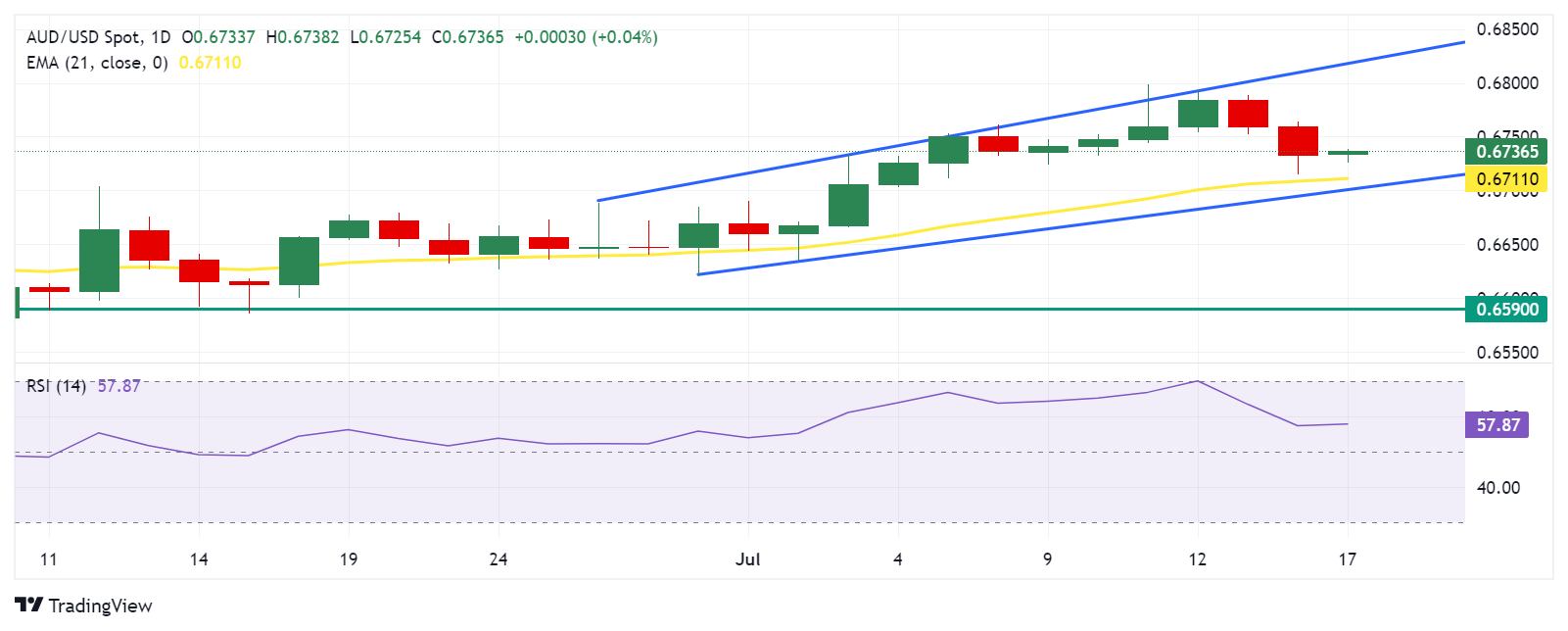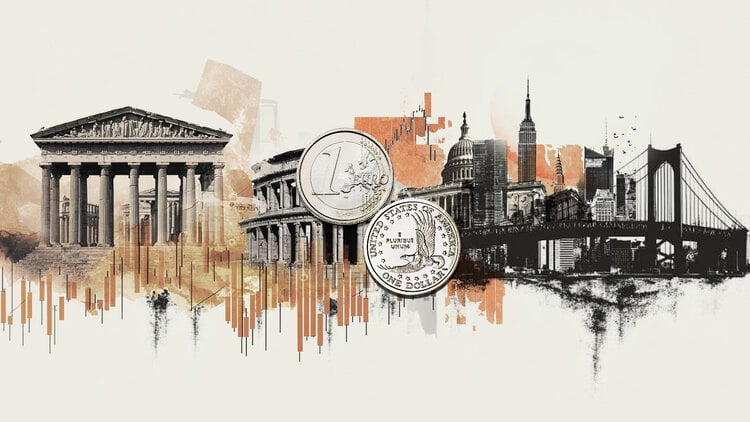- The Australian dollar could lose ground after receiving pressure from a hawkish speech from a Fed member.
- Fed member Dr. Adriana Kugler indicated that rates would be kept on hold for longer if upcoming data do not confirm a slowdown in inflation.
- The yield on Australian 10-year government bonds is holding steady at around 4.2%, its lowest level in three weeks.
The Australian Dollar (AUD) is experiencing volatility on Wednesday. The AUD/USD pair has faced challenges due to a modest rally in the US Dollar (USD), likely influenced by a hawkish speech by Federal Reserve (Fed) Board of Governors member Dr. Adriana Kugler on Tuesday.
In her remarks, Dr. Kugler acknowledged that inflationary pressures have eased, but stressed that the Fed still needs additional data to justify a rate cut. Kugler indicated that if upcoming data do not confirm that inflation is moving toward the 2% target, it may be appropriate to maintain current rates for a while longer.
The AUD/USD pair is losing ground as investors reduce their expectations of a rate hike from the Reserve Bank of Australia (RBA). Despite this, the central bank is still anticipated to delay joining the global rate-cutting cycle. Investors are now focused on Australian employment figures, due out on Thursday, for further insight into the outlook for monetary policy.
Daily Market Wrap: Australian Dollar Under Pressure From a Hardline Fed Member
- The yield on Australian 10-year government bonds is steady around 4.2%, its lowest level in three weeks, mirroring a drop in US bond yields. This followed comments from Federal Reserve Chairman Jerome Powell that strengthened the case for a rate cut by the US central bank in September.
- On Monday, Fed Chair Powell said the three U.S. inflation readings this year “increase some confidence” that inflation is on track to sustainably meet the Fed’s target, suggesting a shift toward interest rate cuts could be imminent.
- US retail sales for June did not change much from the central bank’s expectations. US retail sales were stable at $704.3 billion in June, after a 0.3% increase (revised from 0.1%) in May and in line with market expectations.
- The third plenary session of the 20th National Congress of the Chinese Communist Party continues today, running from July 15-18. Standard Chartered expects cuts from the People’s Bank of China, both in rates and the reserve requirement ratio (RRR), as GDP growth slowed in the second quarter. China’s growth drivers remain uneven and trade tensions are rising, with the US and EU imposing new tariffs on Chinese electric vehicles (EVs).
- San Francisco Federal Reserve Bank President Mary Daly said inflation is cooling in a way that reinforces confidence that it is on track to 2%. However, Daly added that more information is needed before a rate decision is made.
- In China, a close trading partner of Australia, gross domestic product (GDP) grew 4.7% year-on-year in the second quarter, compared with a 5.3% expansion in the first quarter and 5.1% expected.
- The National Bureau of Statistics (NBS) reported that China’s economy operated in a generally stable manner in the first half of the year, with first-half GDP growth of +5.0% year-on-year. Looking ahead, the NBS highlighted the increasing external uncertainties and numerous domestic challenges facing China’s economy in the second half of the year.
Technical Analysis: Australian Dollar Holds Near 0.6750
The Australian dollar is trading around 0.6740 on Wednesday. The daily chart analysis shows that the AUD/USD pair is consolidating within an ascending channel, which indicates a bullish bias. However, the 14-day Relative Strength Index (RSI) is declining towards the 50 level, which suggests a correction. Further decline could weaken the uptrend.
The AUD/USD pair could test the psychological level of 0.6800. A break above this level could support the pair to approach the upper boundary of the ascending channel near 0.6820.
On the downside, immediate support appears around the 21-day exponential moving average (EMA) at 0.6710. Further support is seen near the lower boundary of the ascending channel at 0.6700. A break below this level could push the AUD/USD pair towards the retracement support at 0.6590.
AUD/USD: Daily Chart
Australian Dollar PRICE Today
The table below shows the Australian Dollar (AUD) exchange rate against major currencies today. The Australian Dollar was the strongest currency against the Japanese Yen.
| USD | EUR | GBP | JPY | CAD | AUD | NZD | CHF | |
|---|---|---|---|---|---|---|---|---|
| USD | -0.03% | -0.01% | 0.10% | 0.02% | -0.08% | -0.50% | 0.03% | |
| EUR | 0.03% | 0.04% | 0.12% | 0.05% | -0.05% | -0.51% | 0.07% | |
| GBP | 0.00% | -0.04% | 0.08% | 0.02% | -0.09% | -0.55% | 0.04% | |
| JPY | -0.10% | -0.12% | -0.08% | -0.08% | -0.17% | -0.63% | -0.03% | |
| CAD | -0.02% | -0.05% | -0.02% | 0.08% | -0.11% | -0.54% | 0.03% | |
| AUD | 0.08% | 0.05% | 0.09% | 0.17% | 0.11% | -0.44% | 0.13% | |
| NZD | 0.50% | 0.51% | 0.55% | 0.63% | 0.54% | 0.44% | 0.57% | |
| CHF | -0.03% | -0.07% | -0.04% | 0.03% | -0.03% | -0.13% | -0.57% |
The heatmap shows percentage changes of major currencies. The base currency is selected from the left column, while the quote currency is selected from the top row. For example, if you choose the Australian Dollar from the left column and move along the horizontal line to the US Dollar, the percentage change shown in the chart will represent the AUD (base)/USD (quote).
Interest Rates FAQs
Financial institutions charge interest rates on loans to borrowers and pay them out as interest to savers and depositors. These are influenced by base interest rates, which are set by central banks based on economic developments. Central banks are typically mandated to ensure price stability, which in most cases means targeting an underlying inflation rate of around 2%.
If inflation falls below target, the central bank can cut base interest rates, in order to stimulate lending and boost the economy. If inflation rises substantially above 2%, the central bank typically raises base lending rates to try to reduce inflation.
In general, higher interest rates help strengthen a country’s currency by making it a more attractive place for global investors to park their money.
Higher interest rates influence the price of Gold because they increase the opportunity cost of holding Gold rather than investing in an interest-bearing asset or depositing cash in the bank.
If interest rates are high, the price of the US Dollar (USD) usually rises and since Gold is priced in dollars, the price of Gold falls.
The federal funds rate is the overnight rate at which U.S. banks lend to each other. It is the official interest rate typically set by the Federal Reserve at its FOMC meetings. It is set within a range, for example 4.75%-5.00%, although the upper limit (in this case 5.00%) is the figure quoted.
Market expectations for the Federal Reserve funds rate are tracked by the CME’s FedWatch tool, which measures the behavior of many financial markets in anticipation of future Federal Reserve monetary policy decisions.
Source: Fx Street
I am Joshua Winder, a senior-level journalist and editor at World Stock Market. I specialize in covering news related to the stock market and economic trends. With more than 8 years of experience in this field, I have become an expert in financial reporting.








